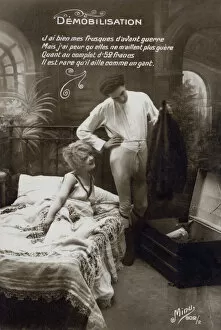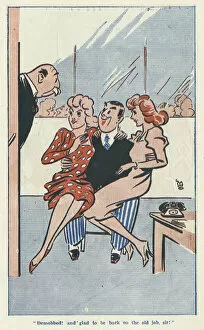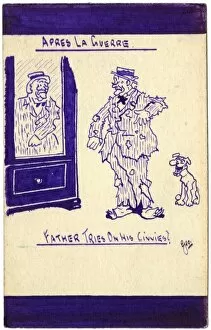Demobbed Collection
"Demobbed: A Glimpse into the Transition from Khaki to Civvies after WW1" In Alfred Leete's iconic cartoon, "Twenty-eight days furlough
All Professionally Made to Order for Quick Shipping
"Demobbed: A Glimpse into the Transition from Khaki to Civvies after WW1" In Alfred Leete's iconic cartoon, "Twenty-eight days furlough, " we witness the anticipation and relief of soldiers as they prepare to return home. Featured in Laugh It Off Annual, this humorous depiction captures the mixed emotions experienced during demobilization. A poignant black and white photo showcases a man unpacking his suitcase, symbolizing the end of military life and the beginning of civilian existence. The image serves as a reminder of the challenges faced by returning servicemen as they reintegrate into society. "The Brides Steamer, " a vibrant color lithograph, portrays an eagerly awaited reunion between soldiers and their loved ones. This joyful scene encapsulates the hope and excitement that filled steamers returning from war-torn lands. Gladys Peto's artwork takes us on a husband hunting expedition, shedding light on how women sought companionship after years of separation due to war. These encounters marked another aspect of post-war readjustment for both men and women alike. The transition from khaki to mufti is captured in Moss Bros' 1918 advertisement titled "From Khaki to Mufti. " This visual representation highlights how clothing played a significant role in signaling one's return to civilian life while promoting Moss Bros' fashionable attire for demobilized soldiers. Wilmot Lunt's comical illustration titled "A Facer" humorously depicts unexpected challenges faced by ex-servicemen upon their return home. This lighthearted take reminds us that even amidst hardships, laughter can be found during times of change. William Heath Robinson's thought-provoking cartoon "Reconstruction" reflects on post-war efforts aimed at rebuilding nations devastated by conflict. It serves as a reminder that demobilization was not just about individual transitions but also collective efforts towards reconstruction. George Ranstead's postcard, "Apres la Guerre no.












